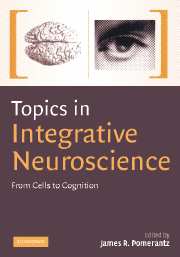Book contents
- Frontmatter
- Contents
- List of contributors
- Preface
- Overview of neuroscience, choice and responsibility
- 1 Neuroscience, choice and responsibility
- PART I HIGHER ORDER PERCEPTION
- PART II LANGUAGE
- PART III MEMORY SYSTEMS
- PART IV SENSORY PROCESSES
- Overview of sensory processes
- 13 Song selectivity, singing, and synaptic plasticity in songbirds
- 14 Voltage-dependent sodium currents in hair cells of the inner ear
- Index
- Plate section
Overview of sensory processes
Published online by Cambridge University Press: 08 August 2009
- Frontmatter
- Contents
- List of contributors
- Preface
- Overview of neuroscience, choice and responsibility
- 1 Neuroscience, choice and responsibility
- PART I HIGHER ORDER PERCEPTION
- PART II LANGUAGE
- PART III MEMORY SYSTEMS
- PART IV SENSORY PROCESSES
- Overview of sensory processes
- 13 Song selectivity, singing, and synaptic plasticity in songbirds
- 14 Voltage-dependent sodium currents in hair cells of the inner ear
- Index
- Plate section
Summary
Understanding of sensory processes has been an ongoing concern for centuries. Consider the study of vision, for example. The early Greeks knew that seeing began in the eye and that the eye was filled with fluid – the humors. But they had no good sense of the eye's optics or of the retina's role; indeed, they thought the retina's job was to provide nutrients for the vitreous. Aristotle believed the humors were photoreceptive. The Pythagoreans believed that rays emanated outward from the eye to the external environment, leading us to wonder today as to what explanation they had in mind for why the world gets dark at night.
In 1604, one hundred years before the publication of Newton's Optics, the German astronomer Johannes Kepler launched a new era in vision when he noted that the eye worked as an optical instrument focusing an image sharply on the retina, observed that the retinal image is in fact oriented upside down and backwards, determined that the lens refracted light, and pinpointed the cause of myopia (before Kepler, people used spectacles to improve their vision but had no idea why curved glass sharpened their sight). There was plenty even Kepler failed to grasp however, including the actual workings of the retina. The discovery of photoreceptors – rods and cones – was over a century away, and when Treviranus officially discovered them in 1834, he misread the orientation of the retina, believing it was installed backwards in the eye (surely the light-sensitive photoreceptors could not be pointing away from the source of light and toward the dark interior of the eye socket!) This echoes the belief, apparently held by some in eras long past, that there exists a second lens in the eye that rectifies the visual image – for as everyone knows, we do not see our world upside down and backwards.
- Type
- Chapter
- Information
- Topics in Integrative NeuroscienceFrom Cells to Cognition, pp. 359 - 362Publisher: Cambridge University PressPrint publication year: 2008



